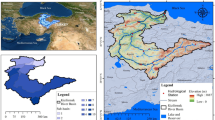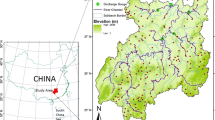Abstract
Interpreting and predicting variations of the water cycle are a significant concern given the emerging threat of climate change. Generically, hydrological components of the water cycle are routinely observed with ground-based measurements, yet it is difficult to measure their spatiotemporal variability. Remote sensing approach is recognized as one of the most promising tools to obtain continuous data over large areas, thereby offering the unique possibility to assess the complicated and non-local features of hydrological phenomena. To estimate water budget components using remote sensing, this research considers precipitation (P), evapotranspiration (ET), and the change in water storage (∆S) calculated from satellites (i.e., Communication, Ocean and Meteorological Satellite; COMS, and Gravity Recovery and Climate Experiment; GRACE) and the Global Land Data Assimilation System (GLDAS) model-based datasets in South Korea from April to December 2011. The P estimates from the COMS rainfall intensity (COMS RI), COMS CM (which employs conditional merging [CM] to improve the accuracy of COMS RI), and GLDAS were compared with the measured P values from the two flux towers on a monthly scale. These results showed that COMS CM and GLDAS are in reasonable agreement, and additionally, their correlation, bias, and root-mean-square errors are favorable compared to the original COMS RI. The ET estimation of GLDAS and COMS applied from the revised RS-PM method were compared which indicated reasonable agreement with the two flux tower measurements. The derived runoff from COMS RI, COMS CM, and GLDAS was evaluated with that of the flux towers. The statistical results indicated that COMS CM and GLDAS were slightly better than that of COMS RI. The spatial distribution of P from COMS CM and GLDAS indicated similar pattern with that of ground-based measurement with the exception of COMS RI. ET from COMS and GLDAS showed slightly analogous pattern. The spatial distribution of runoff from both COMS and GLDAS showed evidence of a seasonality, which mainly resulted from the seasonally varying effects of ET and P. This research shows that it is possible to conduct the analysis of COMS products for efficient water resource planning, monitoring, and water budget modeling.












Similar content being viewed by others
References
An M-H (2007) Development of meterological data processing system of communication, ocean and meteorological satellite, Meteorological Research Institute, Republic of Korea
Baik J, Choi M (2015a) Evaluation of remotely sensed actual evapotranspiration products from COMS and MODIS at two different flux tower sites in Korea. Int J Remote Sens 36(1):375–402
Baik J, Choi M (2015b) Evaluation of geostationary satellite (COMS) based Priestley–Taylor evapotranspiration. Agric Water Manag 159:77–91
Baik J, Choi M (2015c) Spatio-temporal variability of remotely sensed precipitation data from COMS and TRMM: Case study of Korean peninsula in East Asia. Adv Space Res 56:1125–1138
Baik J, Park J, Ryu D, Choi M (2016) Geospatial blending to improve spatial mapping of precipitation with high spatial resolution by merging satellite- and ground based data. Hydrol Process 30(16):2789–2803. https://doi.org/10.1002/hyp.10786
Becker M, LLovel W, Cazenave A, Güntner A, Crétaux J-F (2010) Recent hydrological behavior of the East African great lakes region inferred from GRACE, satellite altimetry and rainfall observations. CR Geosci 342(3):223–233
Cao Y, Nan Z, Cheng G (2015) GRACE gravity satellite observations of terrestrial water storage changes for drought characterization in the arid land of northwestern China. Remote Sens 7(1):1021–1047
Chen X, Alimohammadi N, Wang D (2013) Modeling interannual variability of seasonal evaporation and storage change based on the extended Budyko framework. Water Resour Res 49:6067–6078
Greve P, Gudmundsson L, Orlowsky B, Seneviratne SI (2016) A two-parameter Budyko function to represent conditions under which evapotranspiration exceeds precipitation. Hydrol Earth Syst Sci 20:2195–2205. https://doi.org/10.5194/hess-20-2195-2016
Haile KH (2011) Estimation of terrestrial water storage in the upper reach of Yellow River. Diss. Master’s thesis, retrieved from faculty of geo-information science and earth observation library, University of Twente, Enschede, The Netherlands
Hassan AA, Jin S (2014) Lake level change and total water discharge in the East Africa Rift Valley from satellite-based observations. Global Planet Change 117:79–90
Jin SG, Hassan AA, Feng GP (2012) Assessment of terrestrial water contributions to polar motion from GRACE and hydrological models. J Geodyn 62:40–48. https://doi.org/10.1016/j.jog.2012.01.009
Kalma JD, McVicar TR, McCabe MF (2008) Estimating land surface evaporation: a review of methods using remotely sensed surface temperature data. Surv Geophys 29(4–5):421–469
Kang S, Doh S, Lee D, Lee D, Jin VL, Kimball JS (2003) Topographic and climatic controls on soil respiration in six temperate mixed-hardwood forest slopes, Korea. Glob Change Biol 9:1427–1437
Lee SI, Seo JY, Lee SK (2014) Validation of terrestrial water storage change estimates using hydrological simulation. J Water Resour Ocean Sci 3(1):5–9
Lenk O (2013) Satellite based estimates of terrestrial water storage variations in Turkey. J Geodyn 67:106–110
Li Q, Zhong B, Luo Z, Yao C (2016) GRACE-based estimates of water discharge over the Yellow River basin. Geod Geodyn 7(3):187–193
Marshall M, Tu K, Funk C, Michaelsen J, Williams P, Williams C, Ardö J, Boucher M, Cappelaere B, de Grandcourt A, Nickless A, Nouvellon Y, Scholes R, Kutsch W (2013) Improving operational land surface model canopy evapotranspiration in Africa using a direct remote sensing approach. Hydrol Earth Syst Sci 17:1079–1091. https://doi.org/10.5194/hess-17-1079-2013
Miralles DG, Holmes TRH, De Jeu RAM, Gash JH, Meesters AGCA, Dolman AJ (2011) Global land-surface evaporation estimated from satellite-based observations. Hydrol Earth Syst Sci 15:453–469
Mitsch WJ, Gosselink JG (2000) The value of wetlands: importance of scale and landscape setting. Ecol Econ 35(1):25–33
Mo X, Wu JJ, Wang Q, Zhou H (2016) Variations in water storage in China over recent decades from GRACE observations and GLDAS. Nat Hazards Earth Syst Sci 16:469–482
Mu Q, Heinsch FA, Zhao M, Running SW (2007) Development of a global evapotranspiration algorithm based on MODIS and global meteorology data. Remote Sens Environ 111(4):519–536. https://doi.org/10.1016/j.rse.2007.04.015
Munier S, Aires F, Schlaffer S, Prigent C, Papa F, Maisongrande P, Pan M (2014) Combining data sets of satellite-retrieved products for basin-scale water balance study: 2. Evaluation on the Mississippi Basin and closure correction model. J Geophys Res Atmos 119, 12, 100–12, 116, https://doi.org/10.1002/2014jd021953
Nam W-H, Hong E-M, Choi J-Y (2015) Has climate change already affected the spatial distribution and temporal trends of reference evapotranspiration in South Korea? Agric Water Manag 150:129–138
Oki Taikan, Kanae S (2006) Global hydrological cycles and world water resources. Science 313(5790):1068–1072. https://doi.org/10.1126/science.1128845
Oliveira PTS, Nearing MA, Moran MS, Goodrich DC, Wendland E, Gupta HV (2014) Trends in water balance components across the Brazilian Cerrado. Water Resour Res 50:7100–7114
Park SK, Lee E (2007) Synoptic features of orographically enhanced heavy rainfall on the east coast of Korea associated with Typhoon Rusa (2002). Geophys Res Lett 34:L02803
Park S, Lee Y, Lee BS, Hwang Y, Lee U (2011) Implementation and validation of earth acquisition algorithm for communication, ocean and meteorological satellite. J Astron Space Sci 28:345–354
Park J, Baik J, Choi M (2017) Satellite-based crop coefficient and evapotranspiration using surface soil moisture and vegetation indices in Northeast Asia. CATENA 156:305–314
Ramillien G, Famiglietti JS, Wahr J (2008) Detection of continental hydrology and glaciology signals from GRACE: a review. Surv Geophys 29:361–374
Riegger J, Tourian MJ (2014) Characterization of runoff-storage relationships by satellite gravimetry and remote sensing. Water Resour Res 50:3444–3466
Rodell M, Houser PR, Jambor U, Gottschalck J, Mitchell M, Meng CJ, Arsenault K, Cosgrove B, Radakovich J, Bosilovich M, Entin JK, Walker JP, Lohmann D, Toll D (2004) The global land data assimilation system. BAMS. https://doi.org/10.1175/BAMS-85-3-381
Rodell M, Velicogna I, Famiglietti JS (2008) Satellite-based estimates of groundwater depletion in India. Nature 460:999–1002
Ryu J-H, Han H-J, Cho S, Park Y-J, Ahn Y-H (2012) Overview of geostationary ocean color imager (GOCI) and GOCI data processing system (GDPS). Ocean Sci J 47:223–233
Sahoo AK, Pan M, Troy TJ, Vinukollu RK, Sheffield J, Wood EF (2011) Reconciling the global terrestrial water budget using satellite remote sensing. Remote Sens Environ 115(8):1850–1865
Save H, Bettadpur S, Tapley BD (2016) High-resolution CSR GRACE RL05 mascons. J Geophys Res Solid Earth 121(10):7547–7569
Scanlon BR, Zhang Z, Save H, Wiese DN, Landerer FW, Long D, Longuevergne L, Chen J (2016) Global evaluation of new GRACE mascon products for hydrologic applications. Water Resour Res 52:9412–9429
Schmidt R, Flechtner F, Meyer U, Neumayer KH, Dahle C, Koenig R, Kusche J (2008) Hydrological signals observed by the GRACE satellites. Surv Geophys 29:319–334
Scofield RA, Kuligowski RJ (2003) Status and outlook of operational satellite precipitation algorithms for extreme-precipitation events. Weather Forecast 18(6):1037–1051
Seo JY, Lee SI (2016) Integration of GRACE, ground observation, and land-surface models for groundwater storage variations in South Korea. Int J Remote Sens 37(24):5786–5801
Seo JY, Lee SI (2017) Total discharge estimation in the Korean peninsula using multi-satellite products. Water 9(7):532–540. https://doi.org/10.3390/w9070532
Sheffield J, Ferguson CR, Troy TJ, Wood EF, McCabe MF (2009) Closing the terrestrial water budget from satellite remote sensing. Geophys Res Lett 36:L07403. https://doi.org/10.1029/2009GL037338
Sinclair S, Pegram G (2005) Combining radar and rain gauge rainfall estimates using conditional merging. Atmos Sci Lett 6(1):19–22
Smith SR, Legler DM, Verzone KV (2001) Quantifying uncertainties in NCEP reanalysis using high-quality research vessel observations. J Clim 14:4062–4072
Tapley BD, Bettadpur S, Ries JC, Thompson PF, Watkins MM (2004) GRACE measurements of mass variability in the Earth system. Science 305(5683):503–505
Thiemig V, Rojas R, Zambrano-Bigiarini M, Levizzani V, De Roo A (2012) Validation of satellite-based precipitation products over sparsely gauged African river basins. J Hydrometeorol 13(6):1760–1783
Thomas V, Albert JRG, Hepburn C (2014) Contributors to the frequency of intense climate disasters in Asia-Pacific countries. Clim Change 126(3–4):381–398. https://doi.org/10.1007/s10584-014-1232-y
Tuttle JD, Carbone RE, Arkin PA (2008) Comparison of ground-based radar and geosynchronous satellite climatologies of warm-season precipitation over the United States. J Appl Meteorol Climatol 47(12):3264–3270
Wang A, Zeng X (2012) Evaluation of multi reanalysis products with in situ observations over the Tibetan Plateau. J Geophys Res 117:D05102. https://doi.org/10.1029/2011JD016553
Wang H, Guan H, Gutiérrez-Jurado HA, Simmons CT (2014) Examination of water budget using satellite products over Australia. J Hydrol 511:546–554
Woldemeskel FM, Sivakumar B, Sharma A (2013) Merging gauge and satellite rainfall with specification of associated uncertainty across Australia. J Hydrol 499:167–176
Zhang L, Potter N, Hickel K, Zhang Y, Shao Q (2008) Water balance modeling over variable time scales based on the Budyko framework—model development and testing. J Hydrol 360:117–131
Zhou Y, Jin S, Tenzer R, Feng J (2016) Water stograge variations in the Poyang Lake Basin estimated GRACE and satellite altimetry. Geod Geodyn 7(2):108–116
Acknowledgements
This research was supported by a grant (17AWMP-B079625-04) from Water Management Research Program funded by Ministry of Land, Infrastructure and Transport of Korean government. This work was supported by the National Research Foundation of Korea (NRF) grant funded by the Korea government (MSIT) (NRF-2016R1A2B4008312). This research was supported by Space Core Technology Development Program through the National Research Foundation of Korea (NRF) funded by the Ministry of Science and ICT (NRF-2014M1A3A3A02034789).
Author information
Authors and Affiliations
Corresponding author
Rights and permissions
About this article
Cite this article
Baik, J., Choi, M. Multi-satellite-based water budget components in South Korea. Environ Earth Sci 77, 93 (2018). https://doi.org/10.1007/s12665-018-7271-3
Received:
Accepted:
Published:
DOI: https://doi.org/10.1007/s12665-018-7271-3




